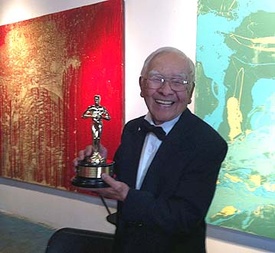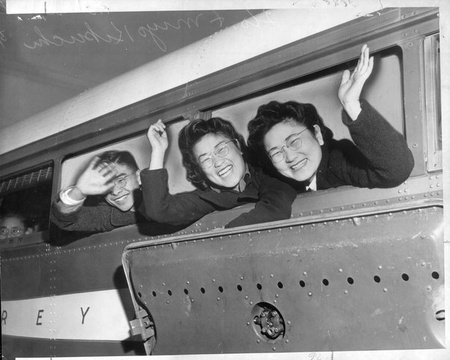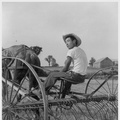Living an American Life
My father, Richard Shigeru Nishimura, was born in Los Angeles in 1922 and celebrated his 94th birthday this year. He shares his memories and feelings much more these days with friends and family, but the most moving and emotional stories he tells are about his detention at Manzanar. My dad is speaking his truth with even more depth and feeling now, compared to when he used to tell me about this part of our family’s history when I was young. Richard Nishimura has a lot of important things to tell everyone about our history and I had to write the story for him and you…
The United States and world history during this period is well known, taught in schools, documented, and is accessible from all types of retrievable archives. Yet Executive Order 9066 and the details of the deportation of Japanese Americans and Japanese immigrants to concentration camps and their suffering are scarcely known. To support my point: In 2015, my dad and I attended the opening of the Ansel Adams Manzanar Photography exhibit at the Skirball Cultural Center. As we went through the exhibit the photos and artifacts displayed brought back painful memories of his experiences in the camp and a young Asian woman stood by us as my dad recounted the story about leaving his home and arriving at Manzanar. This young woman, in her mid-twenties by my estimate, said she grew up in southern California but never heard of EO 9066 or Manzanar. She was learning about it now for the first time at the exhibit.
Understanding Richard Nishimura’s truth and what it means for the thousands of Japanese Americans who experienced this forced unconstitutional incarceration is important now and the future. Richard Nishimura survived the physical, material, and emotional impact of Executive Order 9066 so we can remember and teach all present and future generations about these survivors who were subjected to the social injustice, racial discrimination, humiliation, isolation, and illegal deportment by the US government and military.
Richard is the eldest or first son in the Nishimura family of eight children and was born in Los Angeles making him a natural born citizen of the United States. In 1942, the Nishimura family included his parents Mokutaro (Mark) and Take (pronounced tah-kay); his grandfather Chotaro; his three brothers: George, Donald, and Bryce; and three sisters: Laura, Flora, and Katherine. All went to Manzanar. The fifth Nishimura son, John, was born at the prison camp. Aunt and Uncle Kado and cousins Ida and Louis also went to Manzanar.
Richard Nishimura went to Manzanar ahead of his family and thousands of others, as a volunteer. He was one of a small group of young Japanese Americans to be the first to arrive at Manzanar. Crazy, right? In hindsight, Richard realizes it was crazy and regrets being a pawn and naïve contributor to a cover-up of the truth, but he was asked to go as a volunteer by the pastor of the Maryknoll Japanese Catholic Church of Los Angeles, Father Lavery. The Nishimura family’s religion was Catholic which they embraced through their close relationship with the Barrymore family (actor John Barrymore) who they worked for since Richard’s parents emigrated from Japan to Los Angeles in the early 1920s. The Nishimura family lived and worked on the massive Barrymore estate in Beverly Hills. Richard had no reason to doubt the pastor and his motives.
Fr. Lavery was passionate about his idea to make a saintly example of the intelligent, peaceful, civilized Japanese and prove the fear mongering public was wrong about Japanese Americans being an enemy of the state and a threat to national security. Fr. Lavery’s heart may have been in the right place for his beloved congregation of Japanese Catholic Americans, but the government and media used his young parishioners to show fellow Japanese and the rest of America that they were safe, happy, and fearless to go off to a prison camp as a show of patriotism and honor. The concentration (prison) camp was called a relocation center to make it sound “nicer.”
The volunteers were promised their act of cooperation and volunteerism would make the way easier for their families and thousands of other Japanese that would soon follow. It was just a PR stunt that didn’t make any aspect of the evacuation and relocation easier. It only assured the rest of the Nishimura family would not be separated into different camps, and being together in the same camp was important to Richard. Also, his mother and father were proud that their eldest son made an honorable sacrifice for the family.
Many “news” reports were published publicly all over America during the internment about the status of the Japanese evacuation and relocation to the (prison) camps. These reports falsely indicated how well the “enemy” was being treated by their benevolent government and military. There were many propaganda films and staged photos taken that appeared to show how appreciative and happy these obedient Japanese were for the safe haven they were sent to with all the comforts of “home.” This is a gross lie that should be clearly understood to assure this never happens again to any other group of innocent Americans and immigrants.
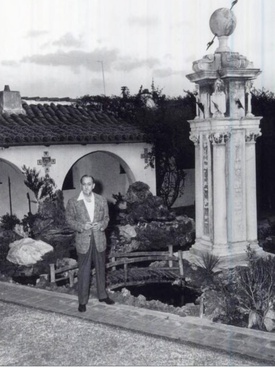
When Richard left the Barrymore estate in Beverly Hills and the Maryknoll church for Manzanar he left behind a new car his Uncle Kado gave him to drive to college (Los Angeles Business College) and to his new job as a clerk for the Los Angeles Department of Water and Power. Richard was the first in his family to be enrolled in college, studying business and accounting. He was excited and proud and had dreams of not only getting his degree at LA Business College but keeping his job at the LADWP and working his way up the corporate ladder. Richard planned on continuing his studies to achieve an advanced degree which would give him the qualifications to become a high ranking manager or director in the LADWP and have an esteemed career “for life,” as he often tells me and others who listen to his stories. Richard Nishimura left his opportunity to fulfill his dream of a life of honor, education, personal and professional success, and financial security when he boarded that bus to Manzanar.
Richard boarded the bus dressed in his best Brooks Brothers suit, hat, and new Bostonian dress shoes which were high school graduation gifts from his parents. He looked sharp, like a successful American businessman. The local newspapers were there reporting on the departure of these cooperative and loyal Japanese going off to a camp and staged a picture of Richard smiling and waving goodbye from the windows on the bus along with two other young Japanese American women. All of the young men and women on the bus presumed they were going to a comfortable detention location that had adequate living accommodations.
After departing downtown Los Angeles escorted by military police, the bus stopped along the road and paper was put up on the windows so the passengers could not see where they were going. A few hours later they finally arrived at their destination—Manzanar. When Richard stepped off the bus along with the others, his impeccably polished dress shoes met the dusty, sandy ground of the desert and a strong harsh wind blew dust all over his suit, shoes, face, and stung his nose and eyes. The first thoughts that went through his mind were, “Why didn’t anyone tell us we were going to the desert? We should have been warned so I could have worn jeans and boots instead of my best suit and shoes.” His attire was just the first of many frustrations and difficulties that lay ahead for him and the rest of the Nishimura family that would soon arrive.
As one of the first arrivals to Manzanar, Richard was required to help finish constructing the barracks, latrines, and other facilities at the camp. Manzanar was set up just a few days before Richard and the other volunteers arrived and there were only a couple of buildings completed for them to live in while they worked to help clear brush and construct buildings for the thousands that would be coming soon. Richard began to worry about his family and how they, especially his mother, were going to cope with the harsh climate—dry winds relentlessly blowing dust everywhere, the heat of the day, and the cold at night—and the dismal public living quarters. Each barracks was to accommodate several families in one open room. There was no privacy to be grouped like that which was an uncivilized way to live for anyone, especially Japanese. The showers and latrines were also open and afforded no privacy. This was the humiliating and inhumane treatment of people who were not guilty of any crimes other than being Japanese Americans.
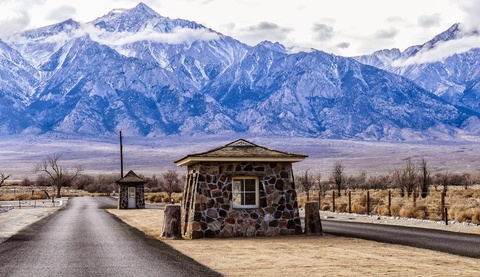
*This article was originally published on the author's blog Nishis Niche on March 21, 2016.
© 2016 Karen Nishimura


